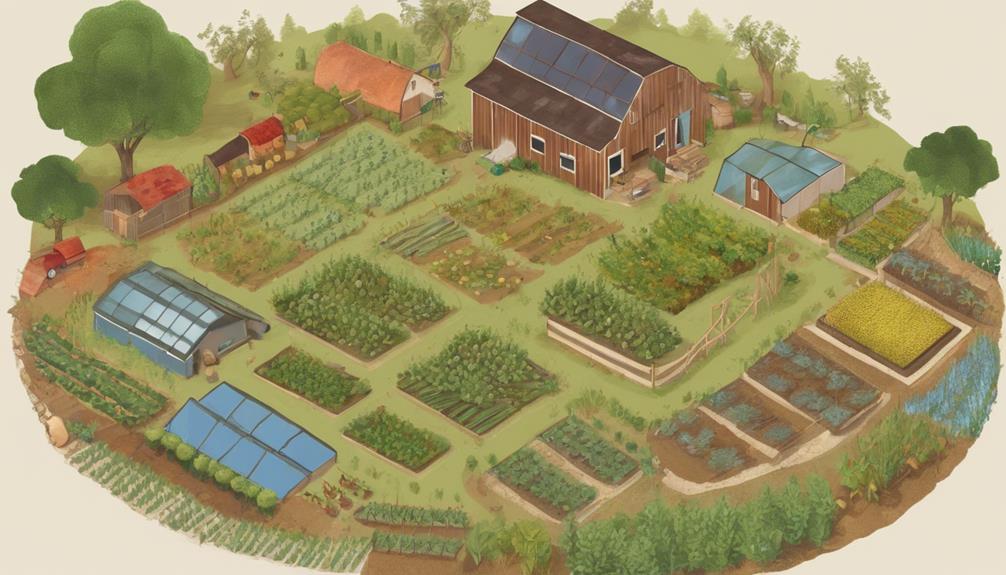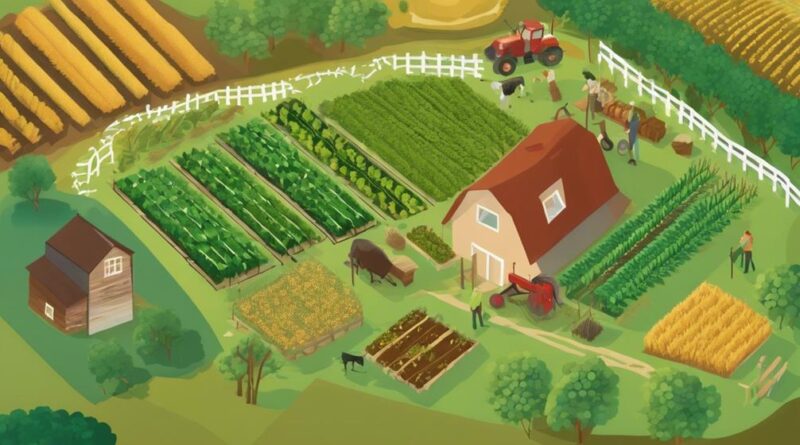7 Best Farming Methods Mitigating Global Warming
To mitigate global warming, consider these seven top farming methods: Regenerative Agriculture boosts soil health. Agroforestry Practices combine trees with crops for carbon storage. No-Till Farming reduces soil disturbance. Cover Cropping protects soil and captures carbon. Crop Rotation Techniques enhance soil quality. Managed Grazing Systems promote biodiversity. Permaculture Design integrates ecosystems. Implementing these strategies is crucial for addressing climate change's effects on our planet. By adopting these methods, you can actively contribute to reducing greenhouse gas emissions and fostering a more sustainable agricultural future.
Regenerative Agriculture
To enhance soil health and promote carbon sequestration, implementing regenerative agriculture practices is vital in combating global warming. Soil restoration plays a crucial role in this process as healthy soils are capable of storing more carbon. Through regenerative agriculture techniques such as minimal tillage, cover cropping, and crop rotation, farmers can improve soil structure, increase organic matter content, and enhance soil biodiversity. These practices not only sequester carbon from the atmosphere but also improve soil fertility and water retention, leading to higher crop yields and reduced reliance on synthetic fertilizers.
Studies have shown that regenerative agriculture can significantly contribute to carbon sequestration. For example, a meta-analysis published in the journal 'Nature Sustainability' found that regenerative farming practices have the potential to sequester up to 3.6 metric tons of carbon per hectare annually. This is achieved through the enhancement of soil organic carbon, which serves as a long-term carbon sink. By transitioning to regenerative agriculture methods, farmers can play a crucial role in mitigating climate change by sequestering carbon dioxide from the atmosphere and improving overall soil health.
Agroforestry Practices
Implementing agroforestry practices alongside regenerative agriculture methods can further enhance carbon sequestration and ecosystem resilience in farming systems. Agroforestry involves integrating trees into agricultural landscapes, providing a range of benefits that contribute to climate change mitigation. One key advantage is tree planting, which plays a crucial role in sequestering carbon from the atmosphere. Trees absorb carbon dioxide during photosynthesis and store it in their biomass and the soil, helping to reduce greenhouse gas concentrations.
Research indicates that agroforestry systems have the potential to sequester significant amounts of carbon. By diversifying agricultural land with trees, farmers can create carbon sinks that offset emissions from other sources. Studies show that agroforestry practices can sequester more carbon compared to conventional farming methods, making them a valuable tool in the fight against global warming.
Furthermore, agroforestry practices enhance ecosystem resilience by improving soil health, conserving water, and promoting biodiversity. The presence of trees in agroecosystems provides habitats for beneficial organisms, enhances nutrient cycling, and reduces soil erosion. These multifaceted benefits not only contribute to climate change mitigation but also support sustainable agricultural production.
No-Till Farming
Utilizing no-till farming practices in agricultural systems has shown promising results in reducing soil disturbance and enhancing carbon sequestration capabilities. This method involves planting crops without plowing the soil, thus helping to maintain its structure and health while also contributing to climate change mitigation efforts.
- Benefits of No-Till Farming:
- Enhanced Soil Health: By reducing soil disturbance, no-till farming preserves soil structure, minimizes erosion, and promotes better water retention.
- Increased Carbon Sequestration: The practice allows for more carbon to remain stored in the soil, aiding in the fight against global warming.
- Cost-Effectiveness: No-till farming can lead to cost savings by reducing fuel, labor, and machinery requirements compared to traditional tillage methods.
- Biodiversity Preservation: The method supports diverse microbial populations in the soil, which can benefit overall ecosystem health and resilience.
Studies have shown that no-till farming systems can significantly reduce greenhouse gas emissions through the prevention of carbon loss from the soil. By adopting these practices, farmers can play a crucial role in mitigating climate change while simultaneously improving the long-term sustainability of their operations. To maximize the benefits of no-till farming, it's essential to provide support and education to farmers, encouraging widespread adoption of this environmentally friendly approach.
Cover Cropping
Cover cropping demonstrates significant potential in enhancing soil fertility and reducing erosion rates in agricultural systems. By planting cover crops such as legumes, grasses, or grains during the off-season or alongside cash crops, farmers can improve soil health through various mechanisms. These plants help prevent soil erosion by covering the ground, reducing surface runoff and keeping the soil structure intact. Additionally, cover crops contribute to soil fertility by fixing nitrogen, increasing organic matter content, and enhancing microbial activity.
One of the key benefits of cover cropping is its role in carbon sequestration. The plant residues left in the soil after cover crops die off act as a carbon source, enriching the soil and aiding in the reduction of greenhouse gases in the atmosphere. Studies have shown that cover cropping can significantly increase soil organic carbon levels, thereby mitigating climate change impacts.
Furthermore, cover cropping has been linked to improved water retention capacity, reduced weed pressure, and enhanced biodiversity on farms. These additional benefits not only support sustainable agricultural practices but also promote resilience in the face of changing climatic conditions. By incorporating cover cropping into farming systems, you can boost soil health, sequester carbon, and contribute to mitigating global warming while maintaining productive and sustainable agricultural practices.
Crop Rotation Techniques
Crop rotation techniques play a crucial role in optimizing soil health and promoting sustainable agriculture practices. By strategically alternating the crops grown in a particular field over different seasons, farmers can enhance soil fertility, reduce erosion, and minimize the build-up of pests and diseases. Here are some key benefits of implementing crop rotation techniques:
- Enhanced Soil Health: Crop rotation helps improve soil structure and fertility by diversifying the types of plants grown in a specific area. Different crops have varying nutrient needs and root structures, which can prevent soil depletion and enhance nutrient cycling.
- Reduced Pest Pressure: Rotating crops disrupts the life cycles of pests and pathogens, reducing their buildup in the soil. This natural pest control method decreases the reliance on chemical pesticides, promoting a more environmentally friendly approach to farming.
- Weed Suppression: Certain crops can help suppress weed growth by shading out unwanted plants or releasing allelopathic chemicals that inhibit weed germination. Rotating crops with these weed-suppressing properties can help reduce the need for herbicides.
- Disease Management: Crop rotation can break the cycle of diseases that affect specific plant species. By rotating crops, farmers can prevent the build-up of pathogens in the soil and minimize the risk of disease outbreaks, ultimately promoting healthier plants and higher yields.
Managed Grazing Systems
Implementing managed grazing systems can significantly enhance soil health and livestock productivity on farms. Rotational grazing, a key component of managed grazing systems, involves moving livestock through different pastures in a planned manner. This practice not only allows for the recovery of grazed areas but also promotes healthier grass growth and soil regeneration. Studies have shown that rotational grazing can improve soil health by increasing organic matter content, enhancing nutrient cycling, and reducing soil erosion.
Holistic management, another important aspect of managed grazing systems, focuses on considering the entire ecosystem within farming practices. By implementing holistic management techniques, farmers can improve biodiversity, water retention, and carbon sequestration in soils. Carbon sequestration, in particular, plays a crucial role in mitigating global warming by removing carbon dioxide from the atmosphere and storing it in the soil.
Permaculture Design

To enhance sustainable farming practices further, exploring Permaculture Design can offer innovative solutions for maximizing agricultural productivity while minimizing environmental impact. Permaculture Design is a holistic approach to sustainable landscaping and ecological farming that focuses on working with nature rather than against it. By implementing Permaculture principles on your farm, you can create a self-sustaining ecosystem that benefits both the environment and your crops.
- Diverse Planting: In Permaculture Design, diverse planting is key to creating a resilient and productive ecosystem. By planting a variety of crops that support each other, you can reduce the need for chemical fertilizers and pesticides.
- Water Conservation: Permaculture emphasizes water conservation techniques such as rainwater harvesting, swales, and mulching. These methods not only help conserve water but also improve soil health and reduce erosion.
- Natural Pest Control: Instead of relying on harmful chemicals, Permaculture promotes natural pest control methods such as companion planting, attracting beneficial insects, and creating habitat for natural predators.
- Soil Regeneration: Permaculture focuses on building healthy soil through techniques like composting, cover cropping, and no-till farming. Healthy soil is the foundation of a productive farm and plays a crucial role in sequestering carbon from the atmosphere.
Conclusion
In conclusion, implementing regenerative agriculture, agroforestry practices, no-till farming, cover cropping, crop rotation techniques, managed grazing systems, and permaculture design can significantly mitigate global warming.
These farming methods not only promote soil health and biodiversity but also sequester carbon, reduce greenhouse gas emissions, and enhance resilience to climate change.
By adopting these sustainable practices, farmers can play a crucial role in combating climate change and creating a more sustainable future for agriculture.
